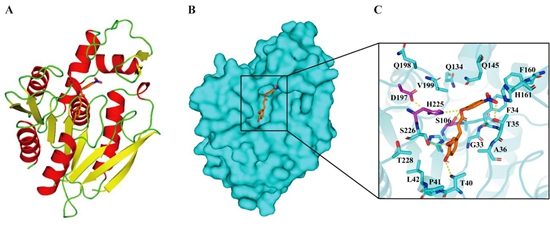Directed Evolution of Feruloyl Esterase from Lactobacillus acidophilus and its Application for Ferulic Acid Production
Recently, the innovation team for food enzyme engineering, has applied a directed evolution method to engineer the Lactobacillus acidophilus feruloyl esterase and aimed to enhance the catalytic efficiency for producing ferulic acid. The relevant research results were published in the journal Bioresource Technology (IF: 9.625) with the title “Directed evolution of feruloyl esterase from Lactobacillus acidophilus and its application for ferulic acid production”.
Ferulic acid (FA) is a kind of hydroxycinnamic acid derivative existing in plant materials, mainly used in pharmaceuticals, cosmetics, and food industries owing to its antioxidant, anti-inflammatory, and anti-cancer biological activities, and it mainly covalently linked to hemi-cellulosic carbohydrate and/or lignin by ester bonds in plant cell walls. Producing ferulic acid (FA) from the natural substrate with feruloyl esterase is promising in industries, screening and engineering new enzymes with high efficiency to increase the FA yield is of great concern. Here, the feruloyl esterase of Lactobacillus acidophilus (FAELac) was heterologous expressed and the FAELac with different oligomerization states was separated. The activity of dimer was 37-fold higher than high-polymer. To further enhance the efficiency of FAELac, eight mutants were generated based on the simulated structure, of which Q198A, Q134T enhanced the catalytic efficiency by 5.4- and 4.3-fold in comparison with the wild type. Moreover, higher yields of FA (2.21, 6.60, and 1.67 mg/g substrate, respectively) were released by the mutants from de-starched wheat bran, insoluble wheat arabinoxylan, and steam-exploded corn stover. These results indicated that improving the purification process, engineering new FAELac and substrates bias studies hold great potential for increasing FA production yield.
PhD candidates Liu Shujun, Lubna Soomro, and Wei Xue are the co-first authors, and assistant researcher Wen Boting and researcher Xin Fengjiao are the co-corresponding authors. This work was supported by the National Key Research and Development Plan “modern food processing and food storage and transportation technology and equipment” (2017YFD0400204), National Natural Science Foundation of China (31801475), and Central Public interest Scientific Institution Basal Research Fund (S2020JBKY-13).

Fig. 1. Structural analysis of the FAELac complex with substrate by homology modeling.

Fig. 2. Hydrolysis of agricultural residues by FAELac and its mutants. Production of FA from (A) I-WAX, (B) DSWB, and (C) SECS. The error bars in the bar graphs represent SEM.
Link to the paper: https://doi.org/10.1016/j.biortech.2021.124967
By Xin Fengjiao (xinfengjiao@caas.cn)
-
 Apr 18, 2024Opening Ceremony of the Training Workshop on Wheat Head Scab Resistance Breeding and Pest Control in Africa Held in CAAS
Apr 18, 2024Opening Ceremony of the Training Workshop on Wheat Head Scab Resistance Breeding and Pest Control in Africa Held in CAAS -
 Apr 03, 2024IPPCAAS Co-organized the Training Workshop on Management and Application of Biopesticides in Nepal
Apr 03, 2024IPPCAAS Co-organized the Training Workshop on Management and Application of Biopesticides in Nepal -
 Mar 28, 2024Delegation from the School of Agriculture and Food Science of University College Dublin, Ireland Visit to IAS, CAAS
Mar 28, 2024Delegation from the School of Agriculture and Food Science of University College Dublin, Ireland Visit to IAS, CAAS -
 Mar 25, 2024Director of World Food Prize Foundation visited GSCAAS
Mar 25, 2024Director of World Food Prize Foundation visited GSCAAS -
 Mar 20, 2024Institute of Crop Sciences (ICS) and Syngenta Group Global Seeds Advance Collaborative Research in the Seed Industry
Mar 20, 2024Institute of Crop Sciences (ICS) and Syngenta Group Global Seeds Advance Collaborative Research in the Seed Industry
